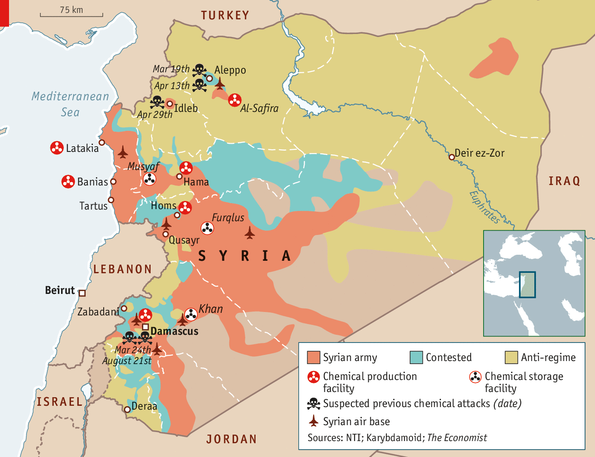This is part 5 of RO’s Arab spring anniversary series. Part 1 looked at Libya. Part 2 analysed Tunisia, part 3 looked at Yemen. Part 4 analysed Egypt. In this installment we analyse where the uprising stands in Syria
By Adnan Khan
Syria continues to perplex the world as the people of this nation, against all odds – be it the winter snow or the use of chemical weapons by the regime – continue in their struggle to attain real change. Syria is different to the other countries that witnessed uprisings in that a full blown war continues to take place between the al-Assad regime on one side and the Muslims of Syria on the other, represented by a plethora of rebel groups. As the uprising in Syria fast approaches three years, there are four clear trends that continue to dominate the landscape. Ever since the start of the revolution 3 years ago, the Syrian landscape has seen many changes; yet the following four trends have continued to persist.
Firstly, the West has failed to cultivate a “moderate” opposition (by Western standards) and viable alternative to al-Assad. This culminated in the US suspending the delivery of non-lethal aid to the North of the country after warehouses of American-supplied equipment were seized by the Islamic Front.[1] The US has been building up the National Coalition and its military wing the Supreme Military Council (SMC) headed by Salim Idris. The National Coalition, which is mainly composed of dissidents who have spent decades outside of Syria, has failed to gain control over groups inside the country. Internal divisions, mainly on whether or not to negotiate with the regime, continue to plague the opposition group. This was seen in March 2013 when Moaz al-Khatib, the president of ‘The National Coalition for Syrian Revolutionary and Opposition Forces’ stepped down, the main reason he cited being the interference by international and regional actors.[2] The Coalition established a transitional government, which remains in exile lacking any organizational base inside the country. The West’s failure was confirmed on December 6, 2013 when the northern Syrian headquarters of General Salim Idris were overtaken by the Islamic Front.[3]
 Secondly, Bashar al-Assad and the West have failed to dilute the Islamic nature of the uprising. Throughout 2013, the Ummah in Syria has been able to maintain the purity of their uprising despite the many attempts by foreign powers to hijack their demand for Islam and to infiltrate the rebel groups. As the uprising continued, a number of Islamic groups and alliances emerged, and today they greatly outnumber the secular and pro-West groups. The announcement of a new coalition based on Islam in September 2013, which included the 11 largest groups in Syria illustrates how the rebels are pooling their resources together and consolidating their positions as they hone in on Damascus. The Islamic nature of the uprising was also confirmed by many of the factions that have a stake in the country. This was clear in a series of interviews aired by Al-Jazeera with leaders of the main armed factions fighting against the al-Assad regime in Syria. Syria’s foreign minister, Walid Al-Moallem in a press conference in June 2013 confirmed what was at stake in the country and the region, when he said: “We know that those who plan evil for Syria and those who demand the establishment of the Islamic Khilafah state will not stop at the borders of Syria. So what we are currently doing is even defending Jordan, Lebanon and Turkey.”[4]
Secondly, Bashar al-Assad and the West have failed to dilute the Islamic nature of the uprising. Throughout 2013, the Ummah in Syria has been able to maintain the purity of their uprising despite the many attempts by foreign powers to hijack their demand for Islam and to infiltrate the rebel groups. As the uprising continued, a number of Islamic groups and alliances emerged, and today they greatly outnumber the secular and pro-West groups. The announcement of a new coalition based on Islam in September 2013, which included the 11 largest groups in Syria illustrates how the rebels are pooling their resources together and consolidating their positions as they hone in on Damascus. The Islamic nature of the uprising was also confirmed by many of the factions that have a stake in the country. This was clear in a series of interviews aired by Al-Jazeera with leaders of the main armed factions fighting against the al-Assad regime in Syria. Syria’s foreign minister, Walid Al-Moallem in a press conference in June 2013 confirmed what was at stake in the country and the region, when he said: “We know that those who plan evil for Syria and those who demand the establishment of the Islamic Khilafah state will not stop at the borders of Syria. So what we are currently doing is even defending Jordan, Lebanon and Turkey.”[4] Thirdly, despite the regime victory in al-Qusayr, the regime has lost almost all of the north of the country, the countryside and some southern areas. The regime is now only defending the corridor from Damascus to Latakia. It was this desperation that led to the al-Assad chemical weapons attack in Ghouta – the Damascus suburb. This was also the regime’s largest chemical attack. In “a telephone call intercepted by German spy chiefs, a senior Hezbollah commander told the Iranian embassy in Lebanon that Bashar Al-Assad launched the chemical attack which killed hundreds of people because he ‘lost his nerve’ in a moment of panic and worried that Damascus would fall to rebel troops.” He continued further, “that Syria’s president intended to tilt the balance of power towards the regime in the battle for control of the country’s capital.”[5]
Thirdly, despite the regime victory in al-Qusayr, the regime has lost almost all of the north of the country, the countryside and some southern areas. The regime is now only defending the corridor from Damascus to Latakia. It was this desperation that led to the al-Assad chemical weapons attack in Ghouta – the Damascus suburb. This was also the regime’s largest chemical attack. In “a telephone call intercepted by German spy chiefs, a senior Hezbollah commander told the Iranian embassy in Lebanon that Bashar Al-Assad launched the chemical attack which killed hundreds of people because he ‘lost his nerve’ in a moment of panic and worried that Damascus would fall to rebel troops.” He continued further, “that Syria’s president intended to tilt the balance of power towards the regime in the battle for control of the country’s capital.”[5]Fourthly, after three years of war the al-Assad regime has failed to deal the opposition a fatal blow. Wherever al-Assad’s regime fought, its strategy has been to crush the opposition by using overwhelming force. Even though the regime has more weapons, they have failed to stem the rebel march to Damascus. Large scale formations against rebel strongholds were countered by the rebel forces utilising asymmetric tactics making it difficult for the regime to rout them. The regime’s advantage of heavy armour was countered by the use of Anti-Tank Guided missiles, which resulted in the rebels neutralising tanks and other ground based equipment. This allowed the rebels to attack airports and other ground infrastructure. The air advantage the regime had was countered by rebel groups targeting air bases and taking them over, which meant that the regime was unable to resupply its troops. Bashar al-Assad was forced to use chemical weapons as many of his other tactics were countered. In May 2013, according to a Hezbollah official, the al-Assad regime was on the verge of collapse. Had Hizbollah not intervened with thousands of its fighters the regime would have fallen.[6]
Despite the multitude of rebel groups, they have been able to survive and take on the regime for three years. The sole strategy followed by the West has been to cobble together a group of loyalists, who will negotiate with al-Assad and eventually join the regime. This was encapsulated by General Dempsey, the chairman of the US Joint Chiefs of Staff: “It is my belief that the [rebel] side we choose must be ready to promote their interests and ours when the balance shifts in their favor. Today, they are not.”[7] For the moment, the US has failed to impose its settlement on Syria. The uprising in Syria is different from the other Arab Spring countries in that the Ummah continues to struggle for real change, irrespective of what has taken place in the wider region. As long as the rebels maintain their internal unity, their march to Damascus to a large extent is inevitable.
Part 1 – Libya
Part 2 – Tunisia
Part 3 – Yemen
Part 4 – Egypt





